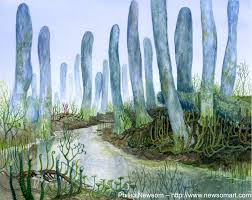Mycelium - Fungi has feelings?
- wildwoodlandlearning
- Feb 26, 2021
- 3 min read
Let's start at the very beginning with this one.
Over 1.3 billion years ago, fungi were the first multi-cell organisms to live on the land of planet Earth. They proceeded to break down geological rock into a life supporting habitat for the plants to grow. The process to create this habitat took around 700 million years, when plants and trees started to appear on earth. I'm finding it quite tricky to imagine a planet without trees, only fungus! Here are some ideas to feed the imagination:
2. Cover of "Journey to the Centre of the Earth"
Fungi has thrived for all this time and is an incredibly important part of our ecosystem. In this blog post I want to attempt to explain what fungi is and how it contributes to the ecosystem. Mycelium is the main part of the fungus that lives in the wood or soil. The word mycelium literally means “more than one”. This refers to the tiny filaments that make up mycelium, they're called hyphae. The hyphae are branching filaments that transport decomposing enzymes, a mass of hyphae is called mycelium.
Mycelium is everywhere as are the minuscule spores that mushrooms send out in to the air. The fruiting body of the fungus sends out these spores to reproduce, when they land on a host (log) they germinate, make more hyphae, mycelium and fruiting bodies, completing the cycle of reproduction. Just like an apple on a tree the mushroom is a fruit of these reproducing fungi. We're not aware but we breath in fungal spores with every breath we take, the fungal spores happily live inside humans too!
As we breathe in fungal spores we walk over miles and miles of mycelium under the ground everyday! For every 1m of tree root there is 1km of mycelium, 30% of soil is made up of fungal mass. These magical connectors can sense changes in their environment and make 'decisions' on their most successful pathways to survival. Does fungus have feelings? Our knowledge of fungus and the extent of its capabilities has a long way to go.
Here you can see mycelium growing in the trunk of a birch tree that has turkey tail growing on it. The tree was recently snapped by strong winds revealing the mycelium inside.
Some species of fungi form symbiotic relationships with plants. Mycorrhizal fungi are associated with plant roots. This relationship is mutually beneficial because mycelium facilitate the transfer of nutrients from the soil into plant roots, and in turn receive carbon from the plant. Carbon is stored by fungi in the soil and therefore is not released as carbon dioxide. It was once thought that plants were the only source of carbon for mycorrhizal fungi. However, research reveals that mycorrhizal fungi can actively decompose organic carbon.
As I mentioned, mycelium can be found on the carcasses of animals as well as trees. This fox has been decomposing for almost 10 weeks and has had vary amounts of mycelium working on it. These photos were taken 3 weeks apart, you can see the mycelium, the white substance around the tummy area.
Fungus has not just survived but thrived over billions of years and has brought many benefits to humans including penicillin (mould) and yeast which provides us with bread and alcohol. It decomposes all the dead wood and animal matter, keeping our woods pleasant and accessible. It provides plants and animals with nutrients to grow. It provides humans food, medicine and joy from the study of mycology. Fungus may also be the answer to the environmental problems facing the planet, we humans should listen to it.
Stop, observe and learn from mother nature, for she has an answer to everything.
Take care,
W.I.L.D.
Referenced with thanks:
If you want to find out more about Fungi, here are a few suggestions:
Entangled Life - Sheldrake
Mycelium Running - Paul Stamets
Fantastic Fungi (film) - Paul Stamets (he also has lots of great YouTube vids and Ted Talks)
























Comments